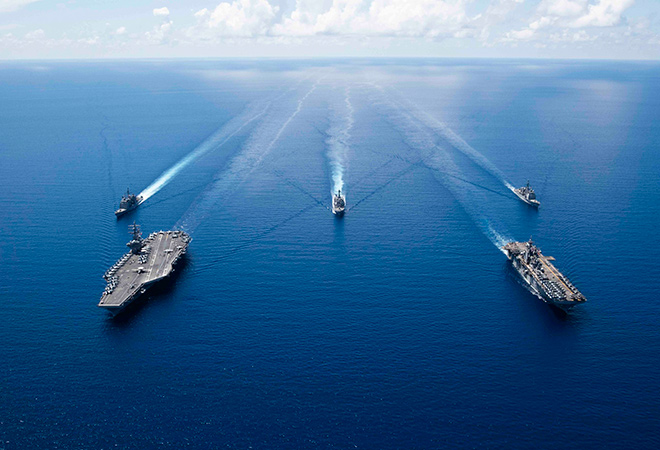
On 13 July 2020 the United States Secretary of State, Mike Pompeo released a statement, which reflects the hardening of the US policy in a “vital, contentious part of the Indo-Pacific region which is the South China Sea”. The US has always maintained a neutral stand on the issue of ‘sovereignty’ in this dispute. The statement claiming that, “Beijing’s claims to offshore resources across most of the South China Sea (SCS) are completely unlawful, as is its campaign of bullying to control them” is clearly symbolic of a shift in the official position of the US. The US’ new policy is in line with the 2016 International Arbitration Tribunal ruling which was in favor of the Philippines and the Chinese historical claims to the maritime resources was declared ‘unlawful’ and beyond the purview of the United Nations Convention on the Law of the Sea (UNCLOS). Though the US has in the past come up with statements showcasing support and giving a nod to the Tribunal ruling, but taking an official stand on Beijing’s maritime claims in the SCS and spelling out that “PRC has no lawful territorial or maritime claim to Mischief Reef or Second Thomas Shoal (off the Philippines), Vanguard Bank (off Vietnam), Luconia Shoals (off Malaysia), waters in Brunei’s EEZ, and Natuna Besar (off Indonesia)” is clearly a departure from the neutral stand on the issue of “territorial claims” as well. The US statement has garnered support from external players like Australia, India, with Australia claiming that it “will continue to support freedom of navigation in the SCS” and India stating that “the SCS was part of global commons and India has an abiding interest in peace and stability in the region.”
It is being presumed that the US statement will be “music to the ears” of the Southeast Asian claimant countries whose claims have received the backing of the US. But is this really the opinion in Southeast Asia about US’ new SCS stance? China not surprisingly has accused Washington of “interfering in the region’s issues and on unnecessarily escalating the situation and sowing discord between China and the Southeast Asian countries.” Therefore, will this statement assure the Southeast Asian countries of protection from the US side in their Exclusive Economic Zones (EEZ) when they face backlash from China’s navy and coast guard fleet during fishing activities or exploration of hydrocarbon resources? Though the statement says that, “America stands with its Southeast Asian allies and partners in protecting their sovereign rights to offshore resources, consistent with their rights and obligations under international law”, but it has been stressed that this support will come in multilateral and legal platforms.
Besides the US, we have seen a hardening of stance from the ASEAN as well. ASEAN countries recently released a vision statement on 26 June 2020 where they underlined the need for China to abide by international law and to fast track the conclusion of the Code of Conduct (COC) for the SCS. The fact that we have always seen a fractured ASEAN when it comes to the SCS issue, this vision statement is undoubtedly a progress and shows that even the Southeast Asian countries are ramping up their China policy. Therefore, at the outset it does appear that the US’ reformed SCS policy will be received well by its ASEAN partners. But given that currently ASEAN is on the process of deliberating a COC with China, which to ASEAN is the only viable mechanism of ensuring peace and calm in the disputed waters, this strong statement from the US side might stall this entire COC discussions. The COC negotiations have been ongoing since 2002, so it already has been a very slow development. At a time when some positive momentum is visible and the ASEAN finally seems united on this contentious issue, a regress is not desirable. The Philippine Presidential spokesperson, Harry Roque, noted that “the two powers would woo his country as they escalate their rivalry, but what is important now is to prioritize the implementation and crafting of a COC to prevent tension in that area.”
Given that currently ASEAN is on the process of deliberating a COC with China, which to ASEAN is the only viable mechanism of ensuring peace and calm in the disputed waters, this strong statement from the US side might stall this entire COC discussions
The Southeast Asian countries have not been able to completely trust or have faith in the US’ Asia policy. The memory of President Trump missing some key ASEAN Summits last year still lies afresh in the minds of the leaders of this region. As quoted in Foreign Policy, Shahriman Lockman, a veteran SCS watcher at the Institute of Strategic and International Studies in Malaysia, said, “The U.S. presence is seen as a double-edged sword. It has the effect of both deterring but also potentially escalating matters with China. The worst-case scenario is for things to escalate, and then the U.S. gets distracted by something in the Middle East, and we get saddled with more Chinese ships in our waters.” A.A. Banyu Perwita, an international relations professor at President University, Jakarta commented that, “It will be not more than a political diplomatic statement to divert attention from Trump's weaknesses at home.” According to Evan Laksmana, Senior Researcher at Centre for Strategic and International Studies (CSIS) Jakarta, “It is nice to reiterate the tribunal ruling- which is what Indonesia has been doing lately. Beyond that, not much has changed. What will be the outcome after this speech still remains to be seen. One speech alone does not mean much without a policy follow up.”
The Southeast Asian countries have not been able to completely trust or have faith in the US’ Asia policy. The memory of President Trump missing some key ASEAN Summits last year still lies afresh in the minds of the leaders of this region
According to analysts, such statements like, “the world will not allow Beijing to treat the SCS as its maritime empire” have increased the possibility of a Sino-US clash in the SCS. As has been mentioned in an article in the South China Sea Morning Post, these kind of statements gives US the leverage to step in if there is a maritime clash between China and any of the rival claimants like Malaysia, Vietnam or the Philippines. This could then eventually lead to a direct clash between the US and China in the contested waters. The Southeast Asian nations have never desired to be in the position where they would need to choose sides. Additionally, they have always feared that Southeast Asia and more importantly the SCS might become the ‘breeding ground’ for great power contestation. For instance, two days after the release of the US statement, Malaysian Foreign Minister, Hishammuddin Hussein called for “countries to refrain from “military posturing” amid tensions in the SCS. We have to avoid military posturing as it is not going to help in solving the problem, and we need all the ASEAN countries to agree on that. Right now, we seem to be on the same page and that’s the only way we can face off with China and the U.S.” Early this month, the USS Reagan and USS Nimitz carrier strike groups conducted exercises in the SCS.
Although, the ASEAN countries might appreciate the external players and especially the US finally circumventing its attention to this region, statements showing all out support for the US’ new policy from the side of the ASEAN countries appears difficult at the moment. As noted by Collin Koh, a research fellow at the S. Rajaratnam School of International Studies in Singapore, “many of the rival claimants are also heavily reliant on China for trade and investment and wary of angering the dominant power in the neighborhood. Their silence on the U.S. statement suggests they don’t want to get ensnared in U.S.-China tensions. For some of them at least, making an official statement in support of Pompeo’s statement could potentially put them in a spot.”
Although, the ASEAN countries might appreciate the external players and especially the US finally circumventing its attention to this region, statements showing all out support for the US’ new policy from the side of the ASEAN countries appears difficult at the moment
The Freedom of Navigation operations has done little to protect the territorial claims of the Southeast Asian nations. In the past year, Chinese oil exploration ships have encroached in waters claimed by Vietnam and Malaysia, and Chinese vessels have sunk Vietnamese and Filipino fishing boats. Similarly if this statement will ensure the safeguarding of territorial claims and sovereign rights of the Southeast Asian countries remain to be seen. As a follow up to this statement, what the US should plan to do is to rally global support for countries like Vietnam, Malaysia who have recently lodged challenges at the UN against China’s nine-dashed line claims. There are reports that Vietnam, like the Philippines is planning take China to the International Arbitration Tribunal to hold it accountable for its vast claims, again garnering international opposition to Chinese claims will be a desirable course of action from the side of the US. China has been trying to negotiate with the Philippines on their territorial dispute and has also been pushing Malaysia to agree to enter in bilateral consultations. The US along with its other partners like Australia, India, Japan should be ensuring that any discussion on the SCS takes place in multilateral platforms like the ASEAN or the EAS. Diplomatic and economic pressure could be put on China to fast track the conclusion of the COC and on terms acceptable to the smaller Southeast Asian nations.
The views expressed above belong to the author(s). ORF research and analyses now available on Telegram! Click here to access our curated content — blogs, longforms and interviews.




 PREV
PREV


